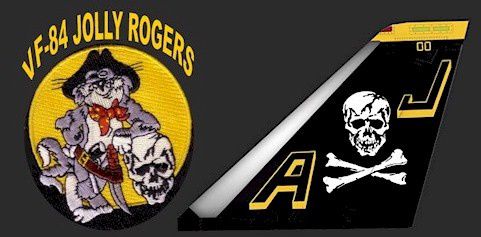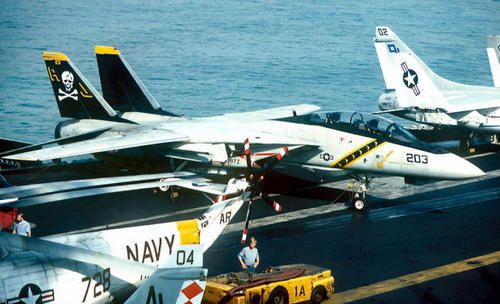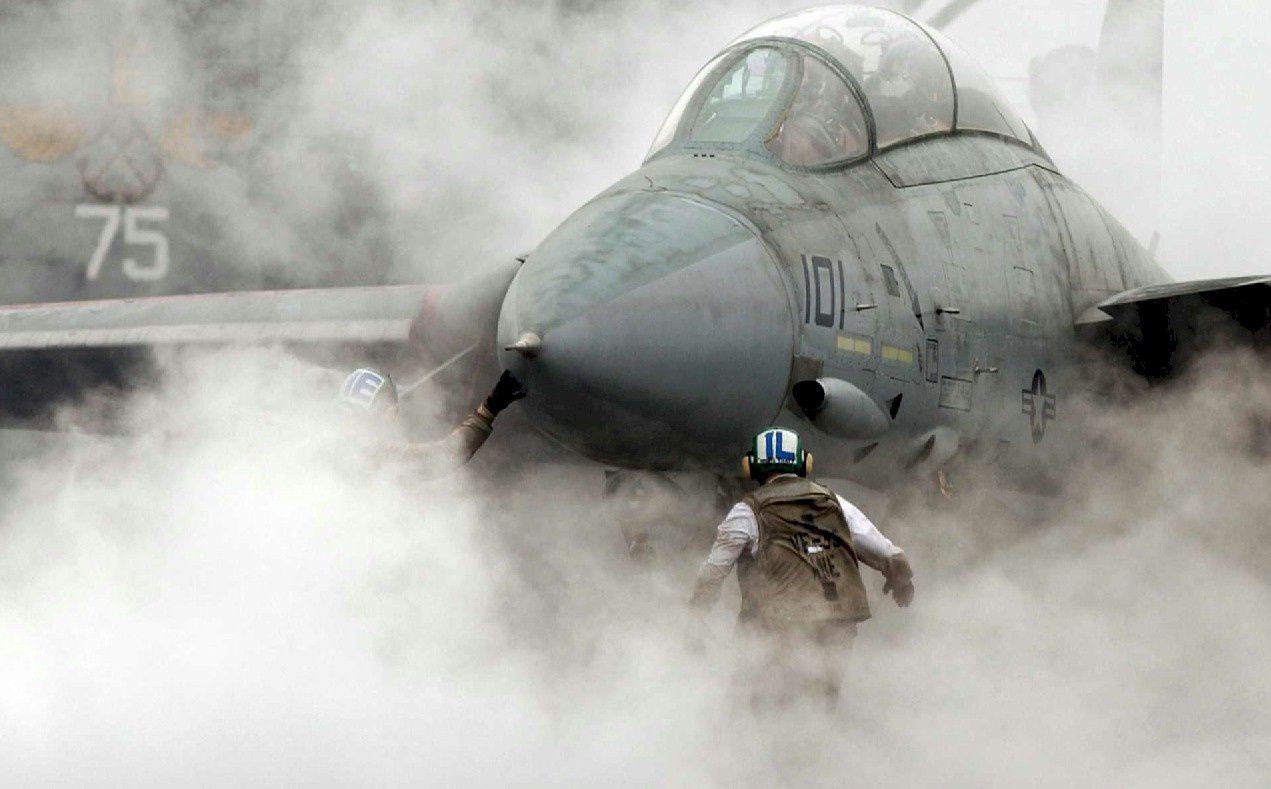





![]()


VF-84 Jolly Rogers
![]()
CALLSIGN: VICTORY
1 July 1955 - 1 October 1995
When VF-84 was first established on 1 July, 1955, at NAS Oceana, they were known as the Vagabonds and the FJ-3 Fury was their mount. The name Jolly Rogers originated from the Fighting Seventeen of World War II fame. VF-17 was one of the first Navy fighter squadrons to receive the F-4Us, they wanted a squadron insignia which would live up to the Corsair name--hence the famous skull-and-crossbones were born. After the disestablishment of VF-17 in April of 1944, the VF-61 became the new Jolly Rogers.
In 1959, VF-61 was disestablished and the then VF-84 Vagabonds requested to carry on the name and insignia of the Jolly Rogers. Approval came down in April 1960 and the skull-and-crossbones were soon adorning their F-8U Crusaders.
VF-84 traded their F-8Us for F-4Bs in 1964 and subsequently they had also flown the F-4J and F-4N variants of the venerable Phantom. The squadron began its transition to the F-14A in early 1976 and after the transition was complete, they embarked on their first major cruise with the new aircraft aboard USS Nitmitz (CVN-68) in December of 1977.
The squadron received the first TARPS pods of the fleet in 1979 and was a pioneer in using the Tomcat as a reconnaissance platform. The Jolly Rogers also played a prominent role in the 1980 motion picture Final Countdown, which propelled the skull-and-crossbones and the F-14 Tomcat to international stardom.
In December 1990, aircraft carrier USS Roosevelt (CVN-71) was called upon to join USS Ranger and USS Midway in the Persian Gulf. Throughout the Gulf War, VF-84 flew combat air patrols for the fleet, escorted the air wing's strike aircraft, and performed TARPS missions to collect bomb damage assessments. After the war, the squadron flew 111 more sorties in support of Operation Provide Comfort before the Roosevelt was finally relieved by USS Forrestal in June 1991.
The Jolly Rogers have always sported some of the most recognizable squadron markings in the world: Sinister white skull-and-crossbones on all-black tails, with gold bands wrapped around the tip of the tail fins, and black bands with gold V's run down the sides of the forward fuselage (these were from the Vagabonds days).
The squadron's prized mascot is a set of skull and crossbones enclosed in a glass encasement. "Passing of the bones" from the outgoing skipper to the incoming skipper is a time-honored Jolly Rogers tradition. The bones are supposedly the remains of ENS Jack Ernie of VF-17.
Ernie was killed during the Okinawa invasion in World War II, as his flaming aircraft spiralled towards earth, he made one last radio transmission asked "to be remembered with the skull-and-crossbones". Ernie's family later presented the squadron with the set of skull and crossbones and asked the squadron to fulfill Ernie's last wish. He may be lost fifty some years ago, but ENS Jack Ernie's spirit lived on until this day.
The post Cold War downsizing of the Navy has brought about the disestablishment of many squadrons; unfortunately VF-84 was no exception. The squadron spent the last eighteen months of its existence participating in numerous joint service operations, sending its crew to career-advancing venues, honing their ACM, strike, and TARPS skills, and they even made a memorable appearance in yet another motion picture--Executive Decision.
Not too long after VF-84's disestablishment on 1 October, 1995, the VF-103 Sluggers adopted the name and insignia of the Jolly Rogers and the "bones" were passed on to them. No matter how times may change, there will always be someone to carry on the pride and tradition of the Jolly Rogers!
![]()










![]()

![]()
![]()

F-14 TOMCAT - A to D
![]()
The F-14 Tomcat is the US Navy's carrier-based two-seat air defence, intercept, strike and reconnaissance aircraft. The aircraft was developed by Northrop Grumman to replace the F-4 Phantom fighter and entered service with the US Navy in 1972. In 1987, the F-14B with an upgraded engine went into production. Further upgrades in the radar, avionics and missile capability resulted in the F-14D Super Tomcat, which first flew in 1988.
The US Navy operated 338 F-14 aircraft of all three variants, but the aircraft is being replaced by the F/A-18E/F Super Hornet. In July 2006, the F-14 made its last carrier launch and, on September 22nd 2006 the US Navy officially retired the F-14 Tomcat.
The variable sweep wing and the twin almost upright tail fins of the F-14 Tomcat give the aircraft its distinctive appearance. The variable sweep wings are set at 20° for take-off, loitering and landing, and automatically change to a maximum sweep of 68°, which reduces drag for high subsonic to supersonic speeds. The wings are swept at 75° for aircraft carrier stowage.
COCKPIT
Catseye night-vision goggles have been installed in the F-14 since 1996 and are supplied by BAE SYSTEMS. The F-14D front cockpit is equipped with a head-up display and two multifunction flat-screen displays. The rear cockpit for the Radar Intercept Officer is equipped with a display that presents fused data from the AN/APG-71 radar and from the suite of aircraft sensors.
82 US Navy F-14Bs are being upgraded with Flight Visions, Inc. Sparrow Hawk HUD and FV-3000 modular mission display system, which will improve reliability and night-vision capability. The cockpit is equipped with the NACES zero/zero ejection seat supplied by Martin Baker Aircraft Company.
WEAPONS
The F-14 is armed with a General Electric Vulcan M61A-1 20mm gun with 675 rounds of ammunition, which is mounted internally in the forward section of the fuselage on the port side. The aircraft has eight hardpoints for carrying ordnance: four on the fuselage and two each side under the fixed section of the wings.
The aircraft can carry the short-, medium- and long-range air-to-air missiles AIM-9, AIM-7 and AIM-54, and air-to-ground ordnance including the Rockeye bomb and CBU cluster bombs. Raytheon AIM-7 Sparrow is a medium-range radar-guided air-to-air missile with range of 45km.
Lockheed Martin/Raytheon AIM-9 Sidewinder is a short-range air-to-air missile with a range of 8km. Raytheon AIM-54 Phoenix is a long-range air-to-air missile with a range of 150km. The F-14 can carry up to six Phoenix missiles and is capable of firing the missiles almost simultaneously at six different targets. The Phoenix missile was retired from US Navy service in October 2004.
The F-14D can carry four Joint Direct Attack Munitions (JDAM). First operational deployment of a precision-guided JDAM from an F-14 was in March 2003.
In 1995, the US Navy installed the Lockheed Martin LANTIRN precision strike navigation and targeting pod on the F-14. The LANTIRN targeting pod includes a dual-field-of-view FLIR and a laser designator/rangefinder. The navigation pod also contains a FLIR and terrain-following radar. A Lockheed Martin infrared search and track system is installed in a sensor pod under the nose.
SENSORS
The F-14D is equipped with a Raytheon AN/APG-71 digital multi-mode radar, which provides non-cooperative target identification, and incorporates low sidelobe techniques and enhanced frequency agility.
The F-14 carries a tactical air reconnaissance pod system (TARPS), which carries a Recon/Optical KS-87B forward or vertical frame camera, and a low-altitude panoramic view KA-99 camera, together with a Lockheed Martin AN/AAD-5 infrared linescanner.
The pod is equipped with a digital imaging system for the transmission of near real-time imagery to the aircraft carrier command centre via a secure UHF radio data link. To supplement TARPS, US Navy F-14s are also being fitted with a fast tactical imagery (FTI) system, which is a line-of-sight system for targeting and reconnaissance.
COUNTERMEASURES
The aircraft is equipped with the BAE Systems Integrated Defense Solutions (formerly Tracor) and Lockheed Martin AN/ALE-39 and AN/ALE-29 chaff, flare and decoy dispensers. The Super Tomcat has a Raytheon AN/ALR-67(V)4 radar warning system and BAE Systems Information & Electronic Warfare Systems (IEWS) (formerly Sanders) AN/ALQ-126 jammer.
ENGINE
The F-14B and the F-14D have two General Electric F110-GE-400 turbofan engines, rated at 72kN and 120kN with afterburn. There are five internal fuel tanks, which carry 9,000 litres and are located in the fixed section and the outer section of the wings, and in the rear section of the fuselage between the engines.

|
Propulsion |
2 Turbofan Engines |
|
|
Engine Model |
Pratt & Whitney |
|
|
Engine Power (each) |
55,6 / 93 kN |
12500 / 20907 lbf |
|
|
|
|
|
Speed |
2.517 km/h |
1.359 kts |
|
|
|
|
|
Empty Weight |
18.036 kg |
39.763 lbs |
|
max. Takeoff Weight |
33.724 kg |
74.349 lbs |
|
|
|
|
|
Wing Span |
19,54 m |
64,1 ft |
|
Length |
19,10 m |
62,7 ft |
|
Height |
4,88 m |
16,0 ft |
|
|
|
|
|
First Flight |
21.12.1970 |
|
|
Production Status |
out of production |
|
|
Total Production |
712 |
|
|
|
|
|
|
Data for (Version) |
Grumman F-14A Tomcat |
|
![]()

![]()





















/idata%2F0396584%2FKOREA%2F71910_korea_MIA1_800.JPG)
/idata%2F0396584%2FU.S.ARMY-POST-WW2%2Fphot4901a.jpg)
/idata%2F0396584%2FDRAWINGS-UNIFORMS-WW2%2F30-451-09b-2.jpg)
/idata%2F0396584%2FP-40%2F44FS000.jpg)
/idata%2F0396584%2FGERMAN-U-BOAT%2FBundesarchiv_Bild_101II-MW-1031-28-_Lorient-_U-31.jpg)
/idata%2F0396584%2FSOVIET-ARMY-WW2%2F1.jpg)




